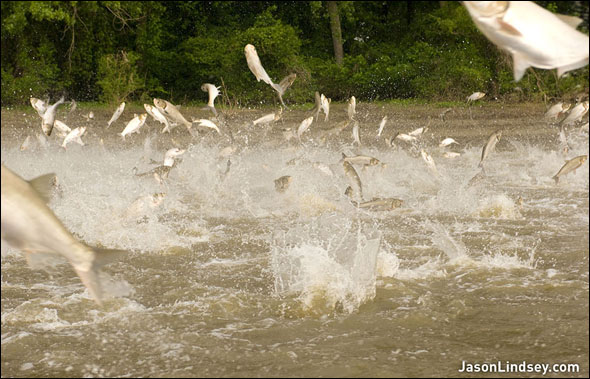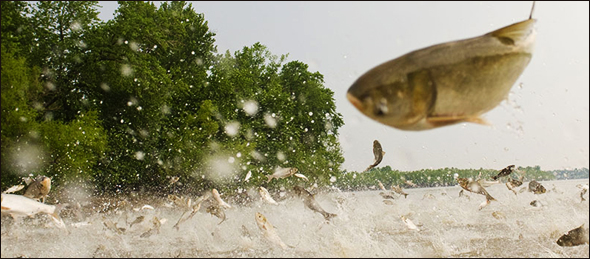After Summer of Testing, Status of Asian Carp in Lake Erie Remains Uncertain
Positive test results for Asian carp eDNA from Lake Erie’s Sandusky and Maumee bays are worrying, but not conclusive.
By Codi Yeager-Kozacek
Circle of Blue
Twenty-three out of a total 500 water samples taken from western Lake Erie this summer have tested positive for Asian carp environmental DNA (eDNA), but researchers have yet to catch a live carp in the lake.
The sampling occurred in the Maumee Bay and River and the Sandusky Bay and River between July 30 and August 4 as part of efforts to follow up on positive eDNA samples collected from the area in 2011. Twenty out of 150 samples taken from the Sandusky Bay area were positive for silver carp, while three out of 350 samples were positive for silver carp in the Maumee Bay area.
Silver carp is one of four invasive Asian carp species — silver, bighead, common and grass — that escaped from aquaculture facilities in the Southern United States in the 1970s and have since infested many waterways in the Mississippi River Basin. The fish are a threat to the Great Lakes region’s $US 7 billion sport-fishing industry, which depends on native species like walleye and yellow perch that could be out-competed by the invasive carp. State and federal efforts — such as the electric barrier in place near Chicago — have, so far, kept the invasion out of the Great Lakes.
But the recent eDNA results raise concerns that at least some carp have gotten into the system, though nobody has seen one.
No Physical Proof
“What we know today, based on extensive sampling, is that (carp) eDNA is present in Sandusky and Maumee Bays in Lake Erie,” Rich Carter, the executive administrator of Fish Management and Research at the Ohio Department of Natural Resources Division of Wildlife, told Circle of Blue. “We know there is a source of eDNA, which could potentially be a live fish or some other unknown source.”
–Rich Carter, executive administrator
Ohio DNR, Fish Management and Research
The eDNA tests can identify genetic material like mucus, feces, and scales in the water and are used to detect species at low abundance levels. But the science cannot yet discern whether this material came from a live or dead fish or from other sources, such as bilge water transported by boats, excrement from fish-eating birds, or melted ice released from fish markets — this means the findings cannot confirm the presence of Asian carp in the Great Lakes without some other, external physical proof.
“This is cause for concern, and we recognize that we need to continue to search for the source of the eDNA,” Carter said. “The evidence suggests that if (the carp) are present, they are present in very low abundance, and we have to recognize that it takes multiple individuals for a chance of reproduction. To date, we have not seen evidence of that.”
Physical proof — in the form of a living, flopping carp — has so far eluded the Michigan and Ohio Departments of Natural Resources (DNR) and the United States Fish and Wildlife Service, despite extensive search efforts.
“We followed up the Sandusky eDNA results in Sandusky Bay and River using a combination of electrofishing and gillnetting, where we used the boats to drive fish into the gill nets, and we did not find any live fish,” Carter said. “It is a technique that has been effective in the Illinois River. If the fish were present, we would expect to catch them.”
What Happens If A Live Carp Is Found
This leaves the agencies with a mystery.
“We are befuddled as to how these sources (of eDNA) are getting into the water,” Charlie Wooley, the deputy regional director of the U.S. Fish and Wildlife Service (Midwest Region), told Circle of Blue. He added that the Fish and Wildlife Service and the Army Corps of Engineers are currently working to test possible pathways the eDNA could take to end up in Lake Erie in the absence of a live carp.
If a live carp is found in the lake, a fish poison, like rotenone, would likely be used to survey the area where the carp was caught, Wooley explained.
“Unfortunately, that would kill everything in the area, but then we could see exactly what is there,” he said. “We have done that in the Chicago Area Waterway System (CAWS), so we have some experience with that and would have the same kind of rapid response, if requested by the DNRs.”
–Charlie Wooley, deputy regional director
U.S. Fish & Wildlife (Midwest Region)
In addition, an advanced genetic analysis would be performed on the captured fish to determine its age and place of origin, Carter said. This process was used on three bighead carp caught in Lake Erie in 1995 and 2000, when the results found that the fish had grown up in southern waters and were likely introduced by humans.
“To know that the carp are established, we would have to see various sizes and age groups,” Wooley said. “If we don’t see any evidence that reproduction is occurring, then we don’t have an established population.”
The Key
Wooley said that there is a “concerted effort” to keep the carp out of the Great Lakes, but that the real goal is to find a way to take back territory the carp have already invaded.
“We have rivers like the Upper Mississippi and the Illinois that have just been taken over by these carp,” he said. “The key is to develop a control mechanism, whether it is a chemical or biological control, that we can put into the water and that will only kill silver and bighead carp.”
A similar solution was developed in 1958 to target and control invasive sea lamprey populations in the Great Lakes, when the U.S. Fish and Wildlife Service identified the chemical compound TFM. TFM is applied to streams where the lampreys reproduce. It can cause mortality among species other than lampreys, but the compound is generally considered to do minimal harm to other wildlife when applied in low concentrations. The control efforts have not eradicated the sea lampreys, but they have helped to reduce their numbers.
“Our ultimate goal is to do the same thing for carp, so that we can work to reclaim those great heartland rivers,” Wooley said.
A news correspondent for Circle of Blue based out of Hawaii. She writes The Stream, Circle of Blue’s daily digest of international water news trends. Her interests include food security, ecology and the Great Lakes.
Contact Codi Kozacek













IMO, they really need to be looking into sportsman, fisherman, and recreational interests. So many people trailer their vessels from one watershed to the next. Other people in recreational craft transit the waterways. Are they unknowingly transporting Asian carp eDNA? Have they checked live wells on bassboats and other recreational fishing vessels. What about live bait? What about bilges of recreational craft that transit the MS and OH and head north and south seasonally each year… There are a lot of “snowbirds” out there. Here they are talking about the canals being a major highway for fish transmission, how strange would it be if the actual trailering of recreational vessels OVER the divide is causing the rash of eDNA problems? Some states are getting tough on this vector. States outside the Great Lakes don’t want invasives like zebra mussels anymore than others! States like Minnesota and Nebraska are getting tough on the trailering of boats, establishing mandatory check points and cleaning stations. If zebra mussels can make it over the Rocky Mountains, so can Asian carp eDNA enter the Western Basin of Lake Erie via recreational craft that has been trailered from the OH/MS river watershed. I think it is time to start testing the recreational interests, questioning and tracking their movement among the watersheds.
The Asian Carp Regional Coordinating Committee (ACRCC) will conduct a Level 1 response in Lake Calumet on October 30-31, 2012. The ACRCC Monitoring and Rapid Response Plan (MRRP) calls for a response action after three consecutive eDNA sample sets return positive hits from one location for either silver or bighead carp. A Level 1 response uses ACRCC fisheries biologists, commercial fishermen and electro-fishing and netting operations to look for Asian carp in areas where positive eDNA results have surfaced. The ACRCC is following a set of protocols in the 2012 MRRP which outline specific circumstances that would trigger one of three different response levels.
Go to the Asian carp website and you can find the flow chart for response action. If they find two or more live fish in the water, the next step may be to rotenone the water. Me thinks the eDNA people protested in 2010 when they skipped right to rotenone on the Calumet/Little Calumet river below the lock. At that time, they were also getting positive eDNA hits. When they rotenoned that stretch of 1-2 miles of river, they pulled over 100,000 pounds & 11,000 pieces of fish from over 20 different species… You know how many bighead and silver carp they found? ZERO. ZILCH. Something tells me this forensic tool, eDNA, is way to sensitive. That is why they should be checking the recreational industry, sportsman, and their bait/live wells. I bet the eDNA is being trailered in! What is closing the lock(s)/shipping lanes if a pleasure boat can ramp the stuff in! Live wells hold 30 plus gallons, times that by two for some bass boats… Now times that by 1,000’s of fisherman! And they worry about commercial ballast? LoL… Who’s at the helm of this operation that they miss the obvious! This is the dirty little secret/800 pound gorilla in the the room. Sportsman may be creating their own problem and the canals as the bogeyman get the scapegoat. Man, that would be something if boats were actually trailering the eDNA in over the divide. This is a plausible explanation given how close Lake Erie is to the Ohio River and what a fisherman’s Mecca the western basin is. Same w/the Illinois basin. Anybody watching where these boats are being trailered in from?